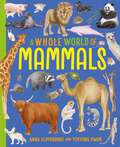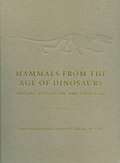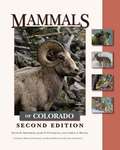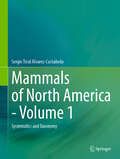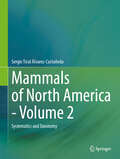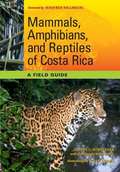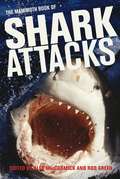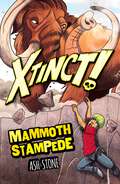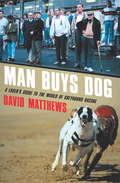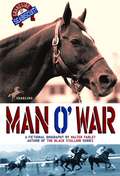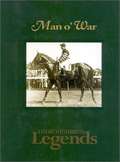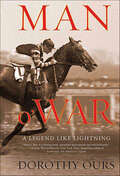- Table View
- List View
Mammalogy Techniques Lab Manual
by James M. RyanGet outside! A hands-on lab manual for instructors incorporating fieldwork into their courses on mammalogy.Mammals inhabit nearly every continent and every sea. They have adapted to life underground, in the frozen Arctic, the hottest deserts, and every habitat in-between. In Mammalogy Techniques Lab Manual—the only field manual devoted to training the next generation of mammalogists—biologist and educator James M. Ryan details the modern research techniques today’s professionals use to study mammals wherever they are found.Ideal for any mammalogy or wildlife biology course, this clear and practical guide aids students by getting them outside to study mammals in their natural environments. Twenty comprehensive chapters cover skull and tooth identification, radio and satellite GPS tracking, phylogeny construction, mark and recapture techniques, camera trapping, museum specimen preparation, optimal foraging, and DNA extraction, among other topics. Each chapter includes several exercises with step-by-step instructions for students to collect and analyze their own data, along with background information, downloadable sample data sets (to use when it is not practical to be out in the field), and detailed descriptions of useful open-source software tools.This pragmatic resource provides students with real-world experience practicing the complex techniques used by modern wildlife biologists. With more than 60 applied exercises to choose from in this unique manual, students will quickly acquire the scientific skills essential for a career working with mammals.
Mammals (A Whole World of... #2)
by Anna ClaybourneGet lost in the diverse and bustling world of mammals - with more to explore than you ever imagined!A Whole World of Mammals presents the stunning breadth of mammal varieties that roam Earth. Who is related to whom? Which type can swim, or fly ... or lay eggs? Where do most mammals with pouches call home, and which mammals live in our homes (whether as pets or uninvited guests)? This book has the answers and so many more facts filling the beautifully illustrated pages.A Whole World of is a book series looking at the extraordinary diversity of life on Earth - the defining features and evolutionary branches - and encourages readers age 7 and up to consider why it is important to maintain biodiversity. Written by award-winning author, Anna Claybourne, with artwork by award-winning illustrator, Yekyung Kwon.Books in the series:A Whole World of Mammals/A Whole World of Prehistoric Life/A Whole World of Minibeasts/A Whole World of Birds/A Whole World of Rocks and Minerals/A Whole World of Plants and Fungi
Mammals from the Age of Dinosaurs: Origins, Evolution, and Structure
by Zofia Kielan-Jaworowska Zhe-Xi Luo Richard CifelliThe fossil record on Mesozoic mammals has expanded by orders of magnitude over the past quarter century. New specimens, some of them breathtakingly complete, have been found in nearly all parts of the globe at a rapid pace. Coupled with the application of new scientific approaches and techniques, these exciting discoveries have led to profound changes in our interpretation of early mammal history. Mesozoic mammals have come into their own as a rich source of information for evolutionary biology. Their record of episodic, successive radiations speaks to the pace and mode of evolution. Early mammals were small, but they provide key information on the morphological transformations that led to modern mammals, including our own lineage of Placentalia. Significant and fast-evolving elements of the terrestrial biota for much of the Mesozoic, early mammals have played an increasingly important role in studies of paleoecology, faunal turnover, and historical biogeography. The record of early mammals occupies center stage for testing molecular evolutionary hypotheses on the timing and sequence of mammalian radiations. Organized according to phylogeny, this book covers all aspects of the anatomy, paleobiology, and systematics of all early mammalian groups, in addition to the extant mammalian lineages extending back into the Mesozoic.
Mammals of Colorado, Second Edition
by David M. Armstrong James P. Fitzgerald Carron A. MeaneyCo-published with the Denver Museum of Nature & Science. Thoroughly revised and updated, Mammals of Colorado, Second Edition is a comprehensive reference on the nine orders and 128 species of Colorado's recent native fauna, detailing each species' description, habitat, distribution, population ecology, diet and foraging, predators and parasites, behavior, reproduction and development, and population status. An introductory chapter on Colorado's environments, a discussion of the development of the fauna over geologic time, and a brief history of human knowledge of Coloradan mammals provide ecological and evolutionary context. The most recent records of the state's diverse species, rich illustrations (including detailed maps, skull drawings, and photographs), and an extensive bibliography make this book a must-have reference. Amateur and professional naturalists, students, vertebrate biologists, and ecologists as well as those involved in conservation and wildlife management in Colorado will find value in this comprehensive volume.
Mammals of Colorado, Second Edition
by David M. Armstrong James P. Fitzgerald Carron A. MeaneyThoroughly revised and updated, Mammals of Colorado, Second Edition is a comprehensive reference on the nine orders and 128 species of Colorado's recent native fauna, detailing each species' description, habitat, distribution, population ecology, diet and foraging, predators and parasites, behavior, reproduction and development, and population status. An introductory chapter on Colorado's environments, a discussion of the development of the fauna over geologic time, and a brief history of human knowledge of Coloradan mammals provide ecological and evolutionary context. The most recent records of the state's diverse species, rich illustrations (including detailed maps, skull drawings, and photographs), and an extensive bibliography make this book a must-have reference. Amateur and professional naturalists, students, vertebrate biologists, and ecologists as well as those involved in conservation and wildlife management in Colorado will find value in this comprehensive volume. Co-published with the Denver Museum of Nature & Science
Mammals of Mexico
by Gerardo CeballosThe most comprehensive reference on Mexico's diverse mammalian fauna.Mammals of Mexico is the first reference book in English on the more than 500 types of mammal species found in the diverse Mexican habitats, which range from the Sonoran Desert to the Chiapas cloud forests. The authoritative species accounts are written by a Who’s Who of experts compiled by famed mammalogist and conservationist Gerardo Ceballos.Ten years in the making, Mammals of Mexico covers everything from obscure rodents to whales, bats, primates, and wolves. It is thoroughly illustrated with color photographs and meticulous artistic renderings, as well as range maps for each species. Introductory chapters discuss biogeography, conservation, and evolution. The final section of the book illustrates the skulls, jaws, and tracks of Mexico’s mammals. This unparalleled collection of scientific information on, and photographs of, Mexican wildlife belongs on the shelf of every mammalogist, in public and academic libraries, and in the hands of anyone curious about Mexico and its wildlife.
Mammals of North America - Volume 1: Systematics and Taxonomy
by Sergio Ticul Álvarez-CastañedaThe book synthesizes nomenclature, systematics, and descriptions of North American mammal species. Clear, simple and illustrated identification keys are provided to make knowledge of mammals easier and facilitate the training both students and professionals in the field, including readers without extensive experience. Descriptions of the different species are provided up to Order, highlighting the diagnostic features that allow identifying them promptly while the reader learns how to make subsequent identifications without having the book at hand. Each species comes with potential distribution maps based on existing records in the main museums of North America. The book includes the description, characteristics and distribution maps of the 781 species with range in the North America subcontinent
Mammals of North America - Volume 2: Systematics and Taxonomy
by Sergio Ticul Álvarez-CastañedaThe second volume of this book series synthesizes nomenclature, systematics, and descriptions of North American mammal species. Clear, simple and illustrated identification keys are provided to make knowledge of mammals easier and facilitate the training both students and professionals in the field, including readers without extensive experience. Descriptions of the different species are provided up to Order, highlighting the diagnostic features that allow identifying them promptly while the reader learns how to make subsequent identifications without having the book at hand. Each species comes with potential distribution maps based on existing records in the main museums of North America. The book includes the description, characteristics and distribution maps of the 781 species with range in the North America subcontinent
Mammals of North America: Second Edition (Princeton Field Guides #58)
by Roland W. Kays Don E. WilsonThe best field guide to North American mammalsThe best-selling field guide that "sets new standards" (New Scientist) and "makes all other field guides for mammals of the United States. . . and Canada obsolete" (Journal of Mammalogy) is now even better. Covering 20 species recognized since 2002 and including 13 new color plates, this fully revised edition of Mammals of North America illustrates all 462 known mammal species in the United States and Canada—each in beautiful color and accurate detail. With a more up-to-date species list than any other guide, improved facing-page descriptions, easier-to-read distribution maps, updated common and scientific names, and track and scat illustrations, this slim, light, and easy-to-use volume is the must-have source for identifying North American mammals.Roland Kays and Don Wilson have scoured the technical literature to pull out the key differences between similar species, and illustrated these whenever possible, making the guide useful to amateur naturalists and professional zoologists alike. Casual animal watchers will appreciate the overview of mammal diversity and the tips on identifying animals they can spy in their binoculars, while scientists will appreciate the exacting detail needed to distinguish similar species, including illustrations of shrew teeth, bat toes, and whale dorsal fins.The best-illustrated and easiest-to-use field guide to North American mammalsBeautiful and accurate color illustrations of all 462 mammals found in the United States and Canada—including 20 species recognized since 2002112 color plates—including 13 new onesKey identification information—fully revised—on facing pagesThe most current taxonomy/species listFully revised, easy-to-read range mapsIllustrations of tracks, scat, and whale and dolphin dive sequences
Mammals of Ungava and Labrador: The 1882-1884 Fieldnotes of Lucien M. Turner together with Inuit and Innu Knowledge
by Tim Flannery Scott A. Heyes Bryony Anderson Kristofer M. HelgenIn 1882 the Smithsonian Institution Arctic scientist, Lucien McShan Turner, traveled to the Ungava District that encompasses Northern Quebec and Labrador. There he spent 20 months as part of a mission to record meteorological data for an International Polar Year research program. While stationed at the Hudson's Bay Company Trading Post of Fort Chimo in Ungava Bay, now the Inuit community of Kuujjuaq, he soon tired of his primary task and expanded his duties to a study of the natural history and ethnography of the Aboriginal peoples of the region. His ethnography of the Inuit and Innu people was published in 1894, but his substantial writings on natural history never made it to print. Presented here for the first time is the natural history material that Lucien M. Turner wrote on mammals of the Ungava and Labrador regions. His writings provide a glimpse of the habits and types of mammals that roamed Ungava 125 years ago in what was an unknown frontier to non-Inuit and non-Innu people.
Mammals of the Great Lakes Region, 3rd Ed.
by Allen KurtaNow in an extensively revised 3rd edition, Mammals of the Great Lakes Region has been an essential reference for countless amateur and professional naturalists since 1957. Easily tucked into a backpack and carried into the field, this heavily illustrated guidebook offers detailed information on 83 species, including each mammal’s appearance, behavior, and natural history, along with an explanation of its scientific name. Species accounts are accompanied by new color photographs plus fully updated distribution maps showing the geographic range in the Great Lakes region and in North America. A thorough introduction outlines the environmental factors that affect the distribution and abundance of mammals in Great Lakes ecosystems and discusses the impacts of current human activities, including introduction of diseases and climate change. There is also a section on preparing captured specimens for research or teaching, as well as user-friendly keys and quick reference tables to physical measurements and life history data. Brand new in this edition, the book also features detailed illustrations of the tracks of commonly found mammals to assist with year-round identification. Providing the most up-to-date information on mammals in the Great Lakes basin, this book belongs on the shelves of teachers, students, naturalists, and professional biologists throughout the region.
Mammals of the Rocky Mountains
by Chris Fisher Don Pattie Tamara HartsonThis fascinating and readable textbook describes these mammals in detail-what they look like, what they eat, where they live, what they like to do. Since otters intrigue me, here's a sample from the pages about them. Northern River Otter Lontra canadensis It may seem to be too good to be true, but all those playful characterizations of the Northern River Otter are founded on truth. Otters often amuse themselves by rolling about, sliding, diving or "body surfing," and they may also push and balance floating sticks with their noses or drop and retrieve pebbles for minutes at a time. They seem particularly interested in playing on slippery surfaces-they leap onto the snow or mud with their forelegs folded close to their bodies for a streamlined toboggan ride. Unlike most members of the weasel family, river otters are social animals, and they will frolic together in the water and take turns sliding down banks. With their streamlined bodies, rudder-like tails, webbed toes and valved ears and nostrils, river otters are well adapted for aquatic habitats. Even when they emerge from the water to clamber over rocks, there is a serpentine appearance to their progression. The large amounts of playtime they seem to have results from their efficiency at catching prey when it is plentiful. Although otters generally cruise along slowly in the water by paddling with all four feet, they can sprint after prey with the ease of a seal whenever hunger strikes. When an otter swims quickly, it chiefly propels itself with vertical undulations of its body, hindlegs and tail. Otters can hold their breath for as long as five minutes, and, if so inclined, they could swim the breadth of a small lake without surfacing. ... In the past, the Northern River Otter's thick, beautiful, durable fur led to excessive hunting. This file should make an excellent embossed braille copy.
Mammals, Amphibians, and Reptiles of Costa Rica
by Carrol L. HendersonTo help visitors, as well as local residents, identify and enjoy the wildlife of Costa Rica, Carrol L. Henderson published Field Guide to the Wildlife of Costa Rica in 2002, and it instantly became the indispensable guide. Now Henderson has created a field guide dedicated to the monkeys, sloths, treefrogs, lizards, crocodiles, and other animals that travelers are most likely to see while exploring the wild lands of Costa Rica. He includes fascinating information on their natural history, ecology, identification, and behavior gleaned from his forty years of travels, studies, and wildlife viewing in Costa Rica, as well as details on where to see these remarkable and beautiful creatures. The mammals, amphibians, and reptiles are illustrated by stunning and colorful photographs-most of which were taken in the wild by Henderson. A detailed and invaluable appendix that identifies many of Costa Rica's best wildlife-watching destinations, lodges, and contact information for trip-planning purposes completes the volume.
Mammoth Book of Shark Attacks, The (Mammoth Books #395)
by Alex MacCormickThe biggest-ever selection of first-hand accounts and news reports of shark attacks, both recent and historical, shows how sharks are masters of the ocean and how we enter their domain at our own risk. Think you're safe in the Med? Read about the Great Whites that thrive near holiday beaches. Think you're safe in large groups? Read about the sinking of the USS Indianapolis in 1945 when hundreds of sailors floated for days in shark-infested waters, being picked off one-by-one. Think you're safe at home? Read about the 69-year-old man, taking his regular evening swim, jumping off his backyard dock straight into the mouth of a bull shark. Many more extraordinary and gruesome accounts, including the shark-boat skipper who slit open the belly of a 360-kg tiger shark only to have a human head, pelvis, and arm come tumbling out, provide horrific and moving tales of shark encounters. The courage of survivors and those who have risked their lives to save shark attack victims is truly inspirational. Where can you find sharks? Features on different shark species with illustrations, fact boxes and maps show where they lurk around the world. Also included are a selection of full-colour photographs and special sections on the life cycle of a shark, how to avoid a shark attack and how to survive one.
Mammoth Cave National Park: Reflections
by Raymond KlassGo deeper into this national treasure with “a sumptuous collection of photographs [that] captures the wonderment and majesty of the cave system” (Louisville Courier-Journal).Kentucky’s Mammoth Cave National Park is home to the world's longest cave system, boasting over 350 miles of explored and mapped passageways—and geologists estimate that there could be many more miles of this vast subterranean world that remain unexplored. In addition to the renowned Mammoth Cave, the park also includes over 50,000 acres of hills, streams, and forests with nearly seventy miles of scenic trails.The Green River, which plays an integral role in the cave’s ecosystem, winds through this impressive landscape. As an artist-in-residence at the park, nature photographer Raymond Klass was granted access to the cave and the surrounding wilderness. While living at the park, he took thousands of photographs of famous cave formations, such as Frozen Niagara and the Drapery Room, as well as scenery and wildlife not often seen by the general public. Mammoth Cave National Park: Reflections is a record of Klass’s unique visual exploration of the above- and belowground ecosystems within the park.With more than 100 dramatic full-color photographs, accompanied by Klass’s commentary and extracts from the journal he kept while living and working in the park, this book captures the sights and surprises of the vast underground world of the cave system—its labyrinths and mineral formations, remnants of human visitors and gypsum miners, streams and rivers hundreds of feet below the surface, and more.“The detail in the photographs lets the reader absorb the wonder of Mammoth Cave perhaps more than a simple day trip to the park could ever provide.” —Kentucky Living
Mammoth Stampede: Book 4 (Xtinct! #4)
by Ash StoneA giant woolly mammoth comes back to life in this action-packed adventure story.Time is running out! Barron Fox's hunting lodge is opening soon, and Jeevan discovers that he's planning a very big surprise for his guests - a woolly mammoth, brought back to life for them to hunt!If the lodge opens, the animals in the forest will be in danger too. Can Jeevan and his friends launch a daring rescue mission that tramples over Fox's plans?Perfect for fans of Beast Quest, Deadly 60 and Jurassic Park, these action-packed adventures will inspire readers to help save endangered species and combat extinction.
Mammoths and the Environment
by Valentina V. UkraintsevaThe study of fossilised remains of herbivorous animals, particularly those rare findings with well-preserved gastrointestinal tracts filled with plant remains, is crucial to our understanding of the environment in which they lived. Summarising thirty years of research, Ukraintseva presents evidence on plants once eaten by Siberia's major herbivorous mammals. The collection of pollen and plant spores from food remains sheds light on the vegetation of these ancient habitats, enabling researchers to reconstruct local floras of the time. This also promotes further insight into the causes of the extinction of various species due to changing environmental conditions and food availability. Providing a history of the research undertaken, the book also includes specific chapters on the Cherski horse and bison, along with the vegetation and climate of Siberia in the late Anthropogene period, making it a lasting reference tool for graduate students and researchers in the field.
Man Buys Dog
by David MatthewsDavid Matthews, author of the critically acclaimed LOOKING FOR A FIGHT, needed a fresh challenge after he had recovered from being a professional boxer. Drawn to the slightly shady appeal of greyhound racing, and not averse to making some easy money, he decided to learn the tricks of the trade from the inside and buy a greyhound. Unfortunately Zussies Boy, aka Kevin, turned out to be something of a dud, and Matthews soon found out the hard way that in the world of greyhound racing there is only one winner - the hare.
Man Buys Dog
by David MatthewsDavid Matthews, author of the critically acclaimed LOOKING FOR A FIGHT, needed a fresh challenge after he had recovered from being a professional boxer. Drawn to the slightly shady appeal of greyhound racing, and not averse to making some easy money, he decided to learn the tricks of the trade from the inside and buy a greyhound. Unfortunately Zussies Boy, aka Kevin, turned out to be something of a dud, and Matthews soon found out the hard way that in the world of greyhound racing there is only one winner - the hare.
Man Meets Dog
by Konrad LorenzIn this wonderful book, the famous scientist and best-selling author, Konrad Lorenz, 'the man who talked with animals', enlightens and entertains us with his illustrated account of the unique relationship between humans and their pets. Displaying Lorenz's customary humanity and expert knowledge of animals, Man Meets Dog is also a deeply personal and entertaining account of his relationships with his own four-legged friends. With charming sketches on almost every page, Man Meets Dog offers a delightful insight into animal and human thinking and feeling. An essential companion for all lovers of dogs (and cats!).
Man O'War (Black Stallion)
by Walter FarleyWalter Farley, with his seamless storytelling, chronicles the life story of the horse most horse lovers continue to regard as America's greatest Thoroughbred. Through the eyes of a fictional stableboy, Danny Ryan, Farley makes the intricate world of the "Sport of Kings" accessible and exciting to horse lovers and racing fans of all ages. Book jacket.
Man Overboard! (The Mystery Files of Shelby Woo #13)
by Brad Strickland Barbara StricklandShelby goes whale-watching aboard the Nantucket Nell on the very day money disappears from the sight-seeing company's safe. Soon, the prime suspect comes out of hiding and teams up with Shelby to prove his innocence -- and surface with the truth.
Man Walks Into a Barn
by Chad OldfatherA smart, funny memoir exploring the evolution of a man and his relationship with his daughters as they grow up in the grips of the equestrian life. When Chad Oldfather found himself the parent of a toddler who, out of nowhere, became obsessed with horses, he had no idea what awaited. With his younger daughters similarly afflicted, Oldfather was soon enmeshed in the consuming subculture of barns, riding, and horse shows, learning not just about the animals that so inexplicably drew his girls, but also about the people and personalities that populated the spaces around them. A book for parents, whatever their children's interests, and for equestrians, who know what it's like &“on the inside&” (but maybe not what it's like on the outside, looking in), A Man Walks into a Barn is a wise, witty, and, at times, critical look at both the light and dark sides of youth sports, and equestrianism in particular. Readers find themselves rooting for Oldfather as he struggles to be the best dad he can, supporting a child's dreams in the face of long odds and extraordinary expenses. He writes about his parenting choices and the strange world he finds himself in with humor and honesty, critically examining riding's high cost and the inaccessibility and inequality that results. Aware of the flaws and dangers of youth athletics, as well as the benefits, he strives to protect his girls while supporting their ambitions the best ways he knows how. Filled with the joys, heartbreaks, and life lessons that come from training, competition, and time in the company of horses, this is mostly a book about family, and the strong bonds that can form when parent and child join hands and pursue a passion together.
Man o' War (Thoroughbred Legends #1)
by Edward L. BowenThe life and times of Man o' War, whose legend continues to grow more than half a century after his death, are chronicled in this exhaustive biography. Man o' War was bred in Kentucky and quickly became a sports hero through such amazing feats as winning the Belmont Stakes by more than 20 lengths and the Lawrence Realization by 100 lengths. He won an astounding 20 of 21 career races and his descendants continue to influence the Thoroughbred breed today. A wonderful collection of 43 historical photographs are found within the pages of this title. It is a must for every fan of Man o' War and the general racing enthusiast alike! Man o' War was ranked No. 1 in The Blood-Horse magazine's list of the Top 100 Racehorses of 20th Century.
Man o' War: A Legend Like Lightning
by Dorothy OursThe &“riveting&” true story of one of the greatest racehorses who ever lived, &“researched meticulously and told brilliantly&” (Laura Hillenbrand, New York Times–bestselling author of Seabiscuit). His trainer said that managing him was like holding a tiger by the tail. His owner compared him to &“chain lightning.&” His jockeys found their lives transformed by him, in triumphant and distressing ways. Born in 1917, Man o&’ War grew from a rebellious youngster into perhaps the greatest racehorse of all time. He set such astonishing speed records that the New York Times called him a &“Speed Miracle.&” Often he won with so much energy in reserve that experts wondered how much faster he could have gone. Over the years, this and other mysteries would envelop the great Man o' War. The truth remained problematic. Even as Man o&’ War—known as &“Big Red&”—came to power, attracting record crowds and rave publicity, the colorful sport of Thoroughbred racing struggled for integrity. His lone defeat, suffered a few weeks before gamblers fixed the 1919 World Series, spawned lasting rumors that he, too, had been the victim of a fix. Tackling old beliefs with newly uncovered evidence, Man o' War: A Legend Like Lightning shows how human pressures collided with a natural phenomenon and brings new life to an American icon. The genuine courage of Man o' War, tribulations of his archrival, Sir Barton (America&’s first Triple Crown winner), and temptations of their Hall of Fame jockeys and trainers reveal a long-hidden tale of grace, disgrace, and elusive redemption. &“Uncovers the true reasons for Man o&’ War&’s early retirement . . . this is must reading for racing fans, and it will reward anyone with an interest in the history of American sport.&” —Booklist (starred review) &“A masterpiece of historical research.&” —Chicago Tribune

